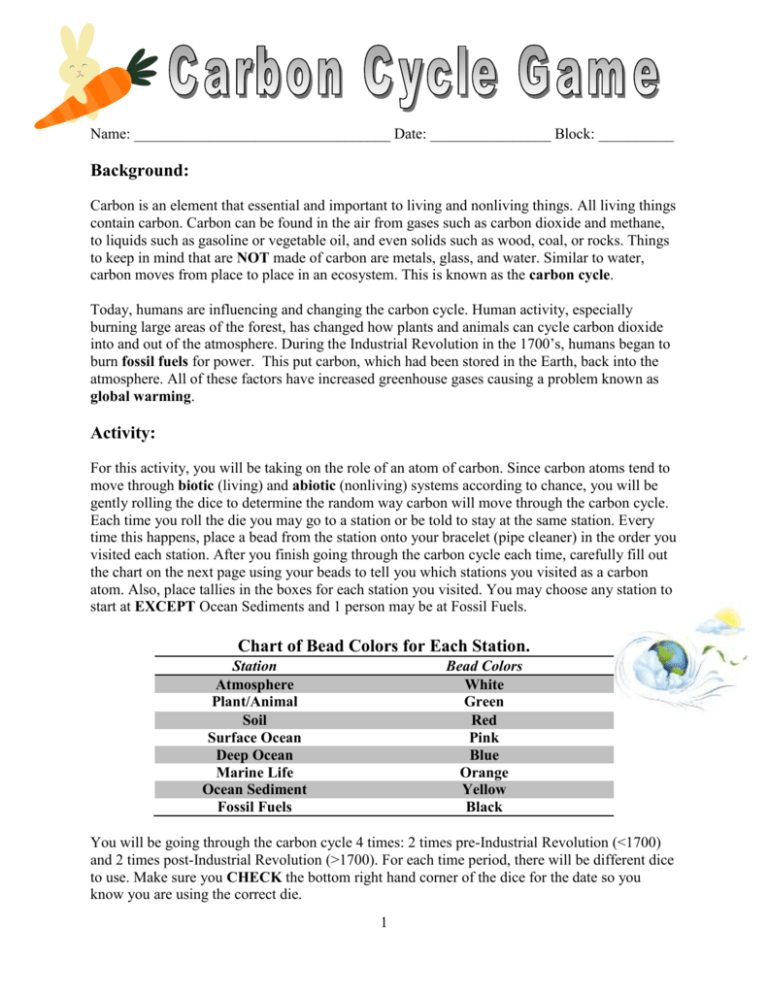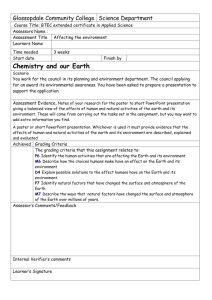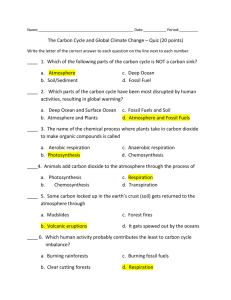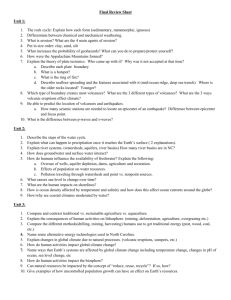Activity Carbon Cycle with beads
advertisement

Name: __________________________________ Date: ________________ Block: __________ Background: Carbon is an element that essential and important to living and nonliving things. All living things contain carbon. Carbon can be found in the air from gases such as carbon dioxide and methane, to liquids such as gasoline or vegetable oil, and even solids such as wood, coal, or rocks. Things to keep in mind that are NOT made of carbon are metals, glass, and water. Similar to water, carbon moves from place to place in an ecosystem. This is known as the carbon cycle. Today, humans are influencing and changing the carbon cycle. Human activity, especially burning large areas of the forest, has changed how plants and animals can cycle carbon dioxide into and out of the atmosphere. During the Industrial Revolution in the 1700’s, humans began to burn fossil fuels for power. This put carbon, which had been stored in the Earth, back into the atmosphere. All of these factors have increased greenhouse gases causing a problem known as global warming. Activity: For this activity, you will be taking on the role of an atom of carbon. Since carbon atoms tend to move through biotic (living) and abiotic (nonliving) systems according to chance, you will be gently rolling the dice to determine the random way carbon will move through the carbon cycle. Each time you roll the die you may go to a station or be told to stay at the same station. Every time this happens, place a bead from the station onto your bracelet (pipe cleaner) in the order you visited each station. After you finish going through the carbon cycle each time, carefully fill out the chart on the next page using your beads to tell you which stations you visited as a carbon atom. Also, place tallies in the boxes for each station you visited. You may choose any station to start at EXCEPT Ocean Sediments and 1 person may be at Fossil Fuels. Chart of Bead Colors for Each Station. Station Atmosphere Plant/Animal Soil Surface Ocean Deep Ocean Marine Life Ocean Sediment Fossil Fuels Bead Colors White Green Red Pink Blue Orange Yellow Black You will be going through the carbon cycle 4 times: 2 times pre-Industrial Revolution (<1700) and 2 times post-Industrial Revolution (>1700). For each time period, there will be different dice to use. Make sure you CHECK the bottom right hand corner of the dice for the date so you know you are using the correct die. 1 Forms of carbon: You will find these at each lab station. Summarize the information on this page. Atmosphere: Plant/Animal: Soil: Surface Ocean: Deep Ocean: Marine Life: Ocean Sediment: Fossil Fuels: 2 THE CARBON CYCLE PRE-1700s: Round 1 Round 2 1. 1. 2. 2. 3. 3. 4. 4. 5. 5. 6. 6. 7. 7. 8. 8. 9. 9. 10. 10. Station Tallies of Times Visited for both rounds pre-1700s Atmosphere Plant/Animal Soil Surface Ocean Deep Ocean Marine Life Ocean Sediment Fossil Fuels 3 THE CARBON CYCLE POST-1700s: Round 1 Round 2 1. 1. 2. 2. 3. 3. 4. 4. 5. 5. 6. 6. 7. 7. 8. 8. 9. 9. 10. 10. Station Tallies of Times Visited for both rounds post-1700s Atmosphere Plant/Animal Soil Surface Ocean Deep Ocean Marine Life Ocean Sediment Fossil Fuels 4 Questions After completing the activity, answer the following questions: 1. This chart will be completed with data collected from the class. Pre-1700s Post-1700s Atmosphere Fossil Fuels 2. Create a line graph for the class data (two lines with key). Put the number of tallies (for atmosphere and fossil fuels) on the Y-axis and pre-1700s and post-1700s on the X-axis. 5 3. Why did some of you get “stuck” as carbon atoms during the Pre-1700’s in the Fossil Fuels station, but not during the Post-1700’s? 4. Why should we look focus only on the data from visits to the Atmosphere and Fossil Fuels stations? 5. If you were at the Ocean Sediments Station, why did you not end up at the Fossil Fuels station in the post-1700s? 6. Why did you visit the Atmosphere station more than the Fossil Fuels station? 7. What are humans doing to move carbon from fossil fuels into the atmosphere? 8. How can humans decrease the amount of carbon being added into the atmosphere? 6 Design a third set of dice reflecting what you believe will represent a carbon atom’s journey Post-2050, knowing how humans have further impacted the carbon cycle in the last three hundred years. Play the game a third time with the newly designed dice. Note changes and have students explain the reasoning behind their results. The Carbon Cycle: Post-2050 Stations Post-2050 Stations 1. ______________________________ (Begin) 2. ______________________________ 1. ______________________________ (Begin) 2. ______________________________ 3. ______________________________ 3. ______________________________ 4. ______________________________ 4. ______________________________ 5. ______________________________ 5. ______________________________ 6. ______________________________ 6. ______________________________ 7. ______________________________ 7. ______________________________ 8. ______________________________ 8. ______________________________ 9. ______________________________ 9. ______________________________ 10. ______________________________ 10. ______________________________ Station Atmosphere Plant/Animal Soil Surface Ocean Deep Ocean Marine Life Ocean Sediment Fossil Fuels Tallies of Times Visited Station Atmosphere Plant/Animal Soil Surface Ocean Deep Ocean Marine Life Ocean Sediment Fossil Fuels 7 Tallies of Times Visited Dice template and activity from: http://www.du.edu/issa/documents/JosieElbertCarbonCycleLesson.pdf 8 Atmosphere Carbon is paired with two atoms of oxygen in the form of carbon dioxide. It can remain in the atmosphere, become part of photosynthesis, or dissolve in the ocean waters. Deep Ocean Carbon is dissolved in the deeper waters of the ocean. It can remain in the deep ocean, settle to the bottom of the ocean as sediment, or move to the ocean’s surface by currents. Plant/Animal Carbon is part of a chain, in a tree trunk, sugar in a fruit, or in the muscle of an animal. It can be respired by a plant or animal into the atmosphere or become part of the soil as the organism decays. Marine Life Carbon is part of a chain in algae or a marine animal. It can be exhaled by marine life and return to the surface of the ocean or become part of the deep ocean when the marine life dies. Soil Carbon is part of a chain, in plant material such as a fallen leaf. It can remain in the soil, be carried downstream to the ocean, develop into a fossil fuel or be released into the atmosphere as part of the decaying process. Ocean Sediment Carbon is part of the material that settles to the bottom of the ocean and will become sedimentary rock. It can either become a fossil fuel after ten million years or be released into the atmosphere when a volcano erupts, releasing carbon dioxide. Surface Ocean Carbon is dissolved in the surface of the ocean. It can remain in the ocean, be released into the atmosphere, be carried deeper into the ocean by currents, or become part of marine life through photosynthesis. Fossil Fuels Carbon is part of a chain in oil, coal, or natural gas. It can remain as a fossil fuel or be released into the atmosphere after it’s been burned for human use. 9







